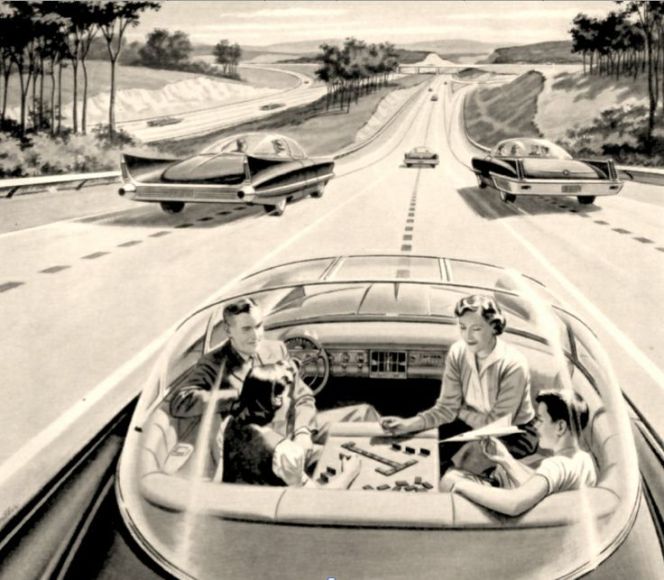Yesterday, TranspoGroup hosted one in series of Autonomous Vehicle Policy conferences. The one-day conference explored how AVs are expected to change transportation and streets, and what municipalities can do to get ready for the anticipated changes.
TranspoGroup's Ryan Snyder stressed that there are still lots of unknowns, and there will likely be unforeseen consequences.
Below are a handful of insights from the proceedings:
When Will the Autonomous Future Arrive?
As far back as 1939, optimistic boosters have predicted that driverless cars were just about a decade away. Technology has come a long way since then, but there are still some (big, deadly) bugs to work out.
Nonetheless, cars with some degree of autonomy are on L.A. streets today.
And there are various degrees of autonomy, with full no-steering-wheel go-anywhere autonomy defined as level five.
Lower-level autonomy - such as adaptive cruise control or self-parking features - are already available as standard features on some cars.
Higher-level autonomy is just around the proverbial corner, with some predictions of various mostly-nearly-autonomous cars guestimated to be coming to market in 2019-2022. Mostly-autonomous transit shuttles (locally touted for Leimert Park and Beverly Hills) are anticipated a little sooner.
Many AV benefits occur when self-driving-vehicles can communicate with each other (called CAVs - Connected Autonomous Vehicles) and with other wired infrastructure. These benefits, such as increased roadway capacity from high-speed cars moving at closer distances, are achieved as CAV saturation is very widespread, which could still be, according to Snyder, "30-40 years" away.
Driving Predicted To Increase
There are some worthwhile benefits expected from AV, including an estimated 40-90 percent safety increase when human error is taken out of driving. The downside is an anticipated increase in driving (measured as VMT - Vehicle Miles Traveled). Folks in AVs won't need to focus on driving, and can instead watch a movie, dive into social media, or sleep. Without the drudgery of driving, longer-distance trips become more bearable, and more common. Miles traveled include more than just those with a person inside the car, but also dead head mileage in between revenue trips. Dystopian scenarios include empty personal AVs circling the block after dropping of their passenger.
The presentation of Jeremy Klopp of Fehr & Peers included data from various AV models, all of which predict increased VMT. The increase in VMT is less when AVs are shared - think Lyft Line or uberPOOL.
Transit Usage Predicted to Decrease
Perhaps a corollary to increased VMT, AV adoption is expected to reduce transit trips. Assuming that removing the driver will make for relatively cheap point-to-point rides, transit riders will choose to hail an AV instead of riding the bus or train. Klopp's presentation graphed data from various AV models, nearly all of which predict a decline in transit trips.
What Cities Can Do Now: Transit Priority, Changing Parking, and Managing Curb Space
With Congress poised to adopt industry-friendly legislation, cities are unfortunately somewhat limited in what they can do. Throughout the day, conference speakers had numerous recommendations for what could be done now. Here are a few:
- Give transit priority: Lauren Mattern of Nelson Nygaard stressed that cities need to prioritize high-capacity vehicles. She recommended carving out dedicated lanes for buses, so they don't get caught in congestion, likely greatly worsened by single-occupancy AVs.
- Reform Parking: Earlier this year, Chandler, AZ, reduced parking requirements on the justification that AVs will need less parking than today's cars. Several speakers urged parking reform - including the Shoup-recommended elimination of governmentally-mandated parking requirements. Experts are recommending changes to parking structures - if deemed necessary, they should be minimized, and built to accommodate later retrofitting - whether to convert to other uses, or even to accommodate AV parking, which is anticipated to take up less space as smaller AVs should be able to park closer together.
- Managing the Curb: Klopp stressed that generally no matter what the federal government legislates, cities will retain much of the control over what happens at the curb - and how space is allocated there - for sidewalks, bike lanes, transit, drop-offs, parking, etc. Cities need to actively manage this space to bring about desired outcomes.
This won't be the last conference (nor the last Streetsblog L.A. article) on autonomous vehicles. TranspoGroup will host additional similar AV conferences - including in Seattle on September 19. Check the TranspoGroup website for details, and for presentations from prior events.






